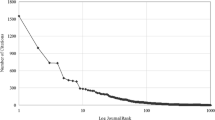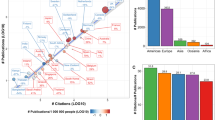Abstract
We analyzed the productivity and visibility of publications on the subject category of Clinical Neurology by countries in the period 2000–2009. We used the Science Citation Index Expanded database of the ISI Web of Knowledge. The analysis was restricted to the citable documents. Bibliometric indicators included the number of publications, the number of citations, the median and interquartile range of the citations, and the h-index. We identified 170,483 publications (84.9 % original articles) with a relative increase of 28.5 % throughout the decade. Fourteen countries published over 2,000 documents in the decade and received more than 50,000 citations. The average of citations received per publication was 8 (interquartile range: 3–20) and the h-index was 261. USA was the country with the highest number of publications, followed by Germany, Japan, the UK and Italy. Moreover, USA publications had the largest number of citations received (44.5 % of total), followed by the UK, Germany, Canada, and Italy. On the other hand, Sweden, the Netherlands and the UK had the highest median citations for their total publications. During the period 2000–2009 there was a significant increase in Clinical Neurology publications. Most of the publications and citations comprised 14 countries, with the USA in the first position. Interestingly, most of the publications and citations originated from only 14 countries, with European countries with relatively low population, such as Switzerland, Austria, Sweden, Belgium, and the Netherlands, in this top group.


Similar content being viewed by others
References
Bornmann, L., & Daniel, H. D. (2009). The state of h index research. EMBO Reports, 10, 2–6.
Chow, D. S., Hauptman, J. S., Wong, T. T., et al. (2012). Changes in stroke research productivity: a global perspective. Surgical Neurology International, 3, 27.
Csajbók, E., Berhidi, A., Vasas, L., & Schubert, A. (2007). Hirsch-index for countries based on Essential Science Indicators data. Scientometrics, 73, 91–117.
Dorta-Contreras, A. J., Arencibia-Jorge, R., Martí-Lahera, Y., & Araujo-Ruiz, J. A. (2008). Productivity and visibility of Cuban neuroscientists: bibliometric study of the period 2001–2005. Reviews Neurology, 47, 355–360.
Falagas, M. E., Michalopoulos, A. S., Bliziotis, I. A., & Soteriades, E. S. (2006). A bibliometric analysis by geographic area of published research in several biomedical fields, 1995–2003. Canadian Medical Association Journal, 175, 1389–1390.
Garfield, E. (2006). The history and meaning of the journal impact factor (2006). JAMA, 295, 90–93.
Hauptman, J. S., Chow, D. S., Martin, N. A., & Itagaki, M. W. (2011). Research productivity in neurosurgery: trends in globalization, scientific focus, and funding. Journal of Neurosurgery, 115, 1262–1272.
Hirsch, J. E. (2005). An index to quantify an individual’s scientific research output. Proceedings of the National Academy of Sciences of the United States of America, 102, 16569–16572.
International comparative performance of the UK research base. (2011). In UK Department for Business, Innovation and Skills (BIS). http://www.bis.gov.uk. Accessed 14/06/2012.
King, D. A. (2004). The scientific impact of nations. Nature, 430, 311–316.
Kulkarni, A. V., Aziz, B., Shams, I., & Busse, J. W. (2009). Comparisons of citations in Web of Science, Scopus, and Google Scholar for articles published in general medical journals. JAMA, 302, 1092–1096.
Leydesdorff, L. (2008). Caveats for the use of citation indicators in research and journal evaluations. JASIST, 59, 278–287.
Marshall, E., & Travis, J. (2011). Scientific impact. U.K. scientific papers rank first in citations. Science, 334, 443.
McVeigh, M. E., & Mann, S. J. (2009). The journal impact factor denominator. Defining citable (counted) items. JAMA, 302, 1107–1109.
Méndez-Vásquez, R. I., Suñén-Pinyol, E., Cervelló, R., & Camí, J. (2008). Bibliometric map of Spain 1996–2004: biomedicine and health sciences. Med Clin (Barc), 130, 246–253.
Ponce, F. A., & Lozano, A. M. (2010). Academic impact and rankings of American and Canadian neurosurgical departments as assessed using the h index. Journal of Neurosurgery, 113, 447–457.
Rodríguez-Navarro, A. (2011). A simple index for the high-citation tail of citation distribution to quantify research performance in countries and institutions. PLoS ONE, 6, e20510.
Roth, D. L. (2005). The emergence of competitors to the Science Citation Index and the Web of Science. Current Science, 89, 1531–1536.
Schubert, A. (2007). Successive h-indices. Scientometrics, 70, 201–205.
Spiroski, M. (2010). Country rank, journal rank and H-index in the field of Medicine in the Republic of Macedonia (1996–2008) using data from Scimago. Macedonian Journal of Medical Science, 3, 99–108.
Stossel, P. T., & Stossel, S. C. (1990). Declining American representation in leading clinical-research journals. New England Journal of Medicine, 322, 739–742.
Sypsa, V., & Hatzakis, A. (2009). Assessing the impact of biomedical research in academic institutions of disparate size. BMC Medical Research Methodology, 9, 33.
The Royal Society. Knowledge, networks and nations (2010) Global scientific collaboration in the 21st century. In: The Royal Society. http://www.royalsociety.org. Accessed 14/05/2012.
Conflict of interest
The authors declare no conflicts of interests.
Author information
Authors and Affiliations
Corresponding author
Rights and permissions
About this article
Cite this article
Iñigo, J., Palma, JA., Iriarte, J. et al. Evolution of the publications in clinical neurology: scientific impact of different countries during the 2000–2009 period. Scientometrics 95, 941–952 (2013). https://doi.org/10.1007/s11192-012-0880-9
Received:
Published:
Issue Date:
DOI: https://doi.org/10.1007/s11192-012-0880-9




